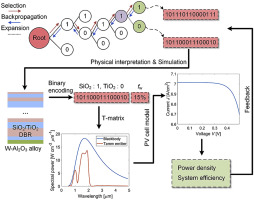Nano Energy ( IF 16.8 ) Pub Date : 2020-03-12 , DOI: 10.1016/j.nanoen.2020.104687 Run Hu , Jinlin Song , Yida Liu , Wang Xi , Yiting Zhao , Xingjian Yu , Qiang Cheng , Guangming Tao , Xiaobing Luo

|
Light-matter interaction upon nanophotonic structures in the infrared wavelength has drew increasing attentions due to the extensive potential applications. Among them, thermophotovoltaic (TPV) systems can exhibit higher efficiency over the Shockley-Queisser limit due to the nanophotonic structure-enabled tunable narrowband thermal emission rather than the broadband incident spectrum. However, two long-standing issues remain formidable as bottlenecks for achieving better performances of TPV system. One is the competing role of the power density and the system efficiency of TPV system, and the other is the magnanimity possibilities of structures, configurations, dimensions, and materials of thermal emitters that disables the manual optimization of TPV system. Here, we attempt to achieve high-performance TPV system by employing the machine learning algorithm under the framework of material informatics. The power density and system efficiency are well modelled through the detailed balance analysis with full considering the photocurrent generation in the PV cells. Through optimization, the non-trial aperiodic Tamm emitters are obtained and the metal-side one is preferable in terms of the TPV performance. The present work is demonstrated to be feasible and efficient in optimizing the TPV performance, and opens a new door for the optimization problems in other fields.
中文翻译:

经过机器学习优化的Tamm发射器,用于高性能热光伏系统,具有详细的平衡分析
由于广泛的潜在应用,在红外波长的纳米光子结构上的光物质相互作用引起了越来越多的关注。其中,由于具有纳米光子结构的可调谐窄带热发射而不是宽带入射光谱,热光电(TPV)系统可以在Shockley-Queisser极限范围内展现出更高的效率。但是,两个长期存在的问题仍然是实现TPV系统更好性能的瓶颈。一个是功率密度和TPV系统的系统效率之间的竞争作用,另一个是热辐射器的结构,配置,尺寸和材料的巨大可能性,从而使TPV系统的手动优化无法进行。这里,我们尝试在物质信息学的框架下采用机器学习算法来实现高性能的TPV系统。通过详细的平衡分析并充分考虑了PV电池中的光电流生成,可以很好地建模功率密度和系统效率。通过优化,获得了非试用的非周期性Tamm发射极,就TPV性能而言,金属侧发射极是优选的。事实证明,目前的工作在优化TPV性能方面是可行和有效的,为其他领域的优化问题打开了新的大门。获得非试用的非周期性Tamm发射体,就TPV性能而言,金属侧的优选。事实证明,目前的工作在优化TPV性能方面是可行和有效的,为其他领域的优化问题打开了新的大门。获得非试用的非周期性Tamm发射体,就TPV性能而言,金属侧的优选。事实证明,目前的工作在优化TPV性能方面是可行和有效的,为其他领域的优化问题打开了新的大门。











































 京公网安备 11010802027423号
京公网安备 11010802027423号